Welcome to our guide on how to enjoy wagashi, the delicate and delicious traditional sweets served during Japanese tea ceremonies. In the Urasenke school of tea, the art of savoring wagashi is an essential part of the experience, as it complements the flavor and aroma of the tea, and enhances the overall atmosphere of tranquility and harmony. Whether you’re a tea ceremony novice or a seasoned practitioner, mastering the etiquette and techniques of wagashi consumption will deepen your appreciation of this timeless cultural ritual. In this article, we’ll provide step-by-step instructions and insights into the history and significance of wagashi in the Urasenke tradition, so you can savor each bite with confidence and grace.
There are two types of Japanese sweets (wagashi) served at Japanese tea ceremony: “higashi (干菓子)” and “omogashi (主菓子). Higashi is served at uscha (thin tea). Usucha is thin tea with a small amount of matcha (powdered green tea). Omogashi is served at koicha (thick tea). Koicha has more than twice the amount of matcha as usucha and less hot water, making it thicker. Here you will learn about “higashi” and “omogashi” and how to eat “higashi” at “tea” (Urasenke). You will also learn Japanese vocabulary and phrases used in “how to eat sweets”.
What is Higashi?
Higashi (干菓子), which are also known as “dried confections,” are an essential part of Japanese tea ceremony. These sweets are made by mixing powder or sugar with a little water and then hardening the mixture. Unlike other Japanese sweets, higashi have a low moisture content, which gives them a dry and crunchy texture.
There are many different types of higashi, including senbei (煎餅), konpeitou (有平糖), and rakugan (落雁) . Senbei are rice crackers that are made from glutinous rice flour and can be flavored with soy sauce, sesame, or other ingredients. Konpeitou are small, colorful sugar candies that are similar to rock candy. Rakugan are dry, hard sweets that are typically made from rice flour and sugar and may be decorated with delicate designs.
In the Urasenke tradition of Japanese tea ceremony, higashi are typically served during the usucha (thin tea) portion of the ceremony. You can learn how to drink usucha here. Guests are expected to eat the higashi before drinking the tea, as the sweetness of the higashi can help to balance out the bitterness of the tea. When enjoying higashi, it is important to savor the texture and flavor of the sweet slowly, as well as to appreciate the artistry of the design and the symbolism behind it.
Senbei
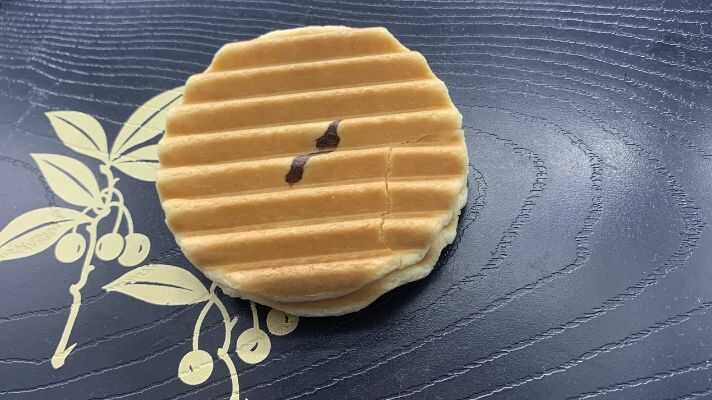
Senbei is a traditional Japanese snack that has been enjoyed for centuries. This pastry is typically made by kneading rice flour or wheat flour with water, rolling the dough out thinly, and then baking it on a griddle or in an oven until it becomes crispy and crunchy. In some cases, other ingredients such as soy sauce, mirin, or sake may be added to the dough to give it additional flavor.
There are many different types of senbei, and they come in a wide range of shapes, sizes, and flavors. Some senbei are round and thin, while others are thick and rectangular. Some are flavored with soy sauce, salt, or nori, while others are coated in a sweet glaze or dusted with seasoning.
Senbei is a versatile snack that can be enjoyed on its own or paired with other foods. In Japanese culture, it is often served with green tea, which helps to balance out the salty or savory flavor of the pastry. In addition to being a popular snack, senbei is also often given as a gift or souvenir, particularly when traveling to other regions in Japan.
Today, senbei can be found in many different places, including convenience stores, supermarkets, and specialty shops. Many people also enjoy making their own senbei at home, using traditional techniques and recipes that have been passed down through the generations.
Click here>>>Senju-senbei

Konpeitou
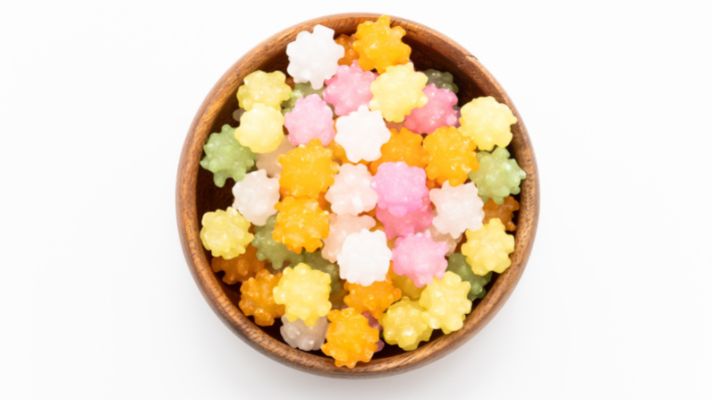
Konpeito, a small candy that originated in Portugal, has been a beloved treat in Japan for centuries. To make konpeito, sugar is mixed with a small amount of water to create a syrup. This syrup is then heated and stirred until it forms small, irregular pellets with a rough surface texture. The candy’s unique shape and texture give it a distinct flavor and mouthfeel, with a burst of sweetness followed by a satisfying crunch.
Initially introduced to Japan as a medicinal sugar during the Muromachi period, konpeito quickly became popular as a sweet treat. Today, it is still enjoyed as a traditional Japanese candy and often given as a gift or used as a decoration for various celebrations. The candy’s name comes from the Portuguese word “confeito,” meaning “confectionery.”
Konpeito can be used as a topping for desserts or enjoyed on its own as a snack. Its popularity has endured for centuries, and it remains a beloved symbol of Japanese confectionery culture.
One of the reasons konpeito has remained so popular over the years is its versatility. The candy comes in a wide range of colors and flavors, from classic sugar to fruity or floral options like cherry blossom or yuzu. It can also be mixed with other ingredients to create unique blends, such as matcha-flavored konpeito or konpeito with added vitamins and minerals.
Whether you’re looking for a sweet treat to enjoy on a lazy afternoon or a colorful topping to add to your desserts, konpeito is an excellent choice. Its unique texture, wide range of flavors, and charming appearance make it a beloved favorite of Japanese sweets enthusiasts around the world.
Click here>>>Konpeito Japanese Tiny Sugar Candy Crystal
Rakugan
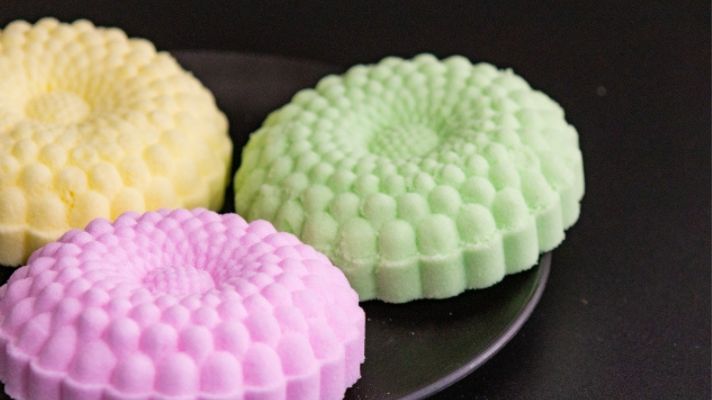
Rakugan is a type of traditional Japanese sweet that has been enjoyed for centuries. These confections are made by kneading grain flour with sugar or syrup to create a dough, which is then pressed into intricate wooden molds to create beautiful and intricate shapes. The dough is then dried until it hardens and takes on a smooth, glossy appearance.
The origins of Rakugan can be traced back to the Edo period (1603-1868), when they were served as a type of ceremonial sweet at tea ceremonies. They were originally made with rice flour and were only available to the upper classes due to their high cost. Over time, the recipe for Rakugan evolved, and wheat flour and sugar became the main ingredients.
Today, Rakugan is enjoyed by people from all walks of life and is often given as a gift or enjoyed as a snack. They are available in a wide range of shapes and sizes, from simple round disks to intricate designs featuring animals, flowers, and other motifs. Some Rakugan even feature delicate hand-painted designs.
One of the unique features of Rakugan is its texture. The confections are hard and crunchy, but they dissolve quickly in the mouth, releasing a burst of sweetness. They are often served alongside green tea or other types of Japanese tea, and are enjoyed for their complementary flavors.
Rakugan can also be used in a variety of culinary applications. They can be crushed and used as a topping for ice cream or other desserts, or added to baked goods such as cookies or cakes to add a sweet, crunchy element. Some chefs even use Rakugan to create unique savory dishes, such as sprinkling it over grilled meats or incorporating it into sauces and marinades.
Click here>>>Rakugan Hanmure
Confectionery Containers for Higashi
Higashi is a type of traditional Japanese confectionery that is often served during tea ceremonies or as a sweet snack. These delicate and intricate sweets are typically made from rice flour, sugar, and natural flavorings such as matcha or sakura. To display and serve higashi, there are two types of traditional containers that are commonly used: higashiki (干菓子器) and furidashi (振出).
Higashiki is a container made of lacquer or wood that is used to store and present higashi. It has a flat base and a wide, shallow shape with a lid to protect the sweets from moisture and dust. The higashiki is often decorated with intricate designs, such as painted landscapes or floral motifs, that reflect the season or occasion. These decorative elements add to the beauty and elegance of the tea ceremony or the presentation of the sweets.
Furidashi, on the other hand, is a type of container that is used to serve higashi during a tea ceremony. It is usually made of ceramic or lacquer and has a cylindrical shape with a removable lid. Unlike the higashiki, which is used for storage and display, the furidashi is designed to be passed around among the guests, who can take one or two higashi to enjoy with their tea. The lid of the furidashi also serves as a small plate for holding the sweets.
Both the higashiki and the furidashi are important elements of Japanese culture and are often considered works of art in their own right. They reflect the delicate beauty and attention to detail that is characteristic of Japanese craftsmanship and design. By using these containers to serve and display higashi, the Japanese celebrate not only the beauty of the sweets themselves, but also the importance of presentation and aesthetics in their culture.
Higashiki
Higashiki(干菓子器), which refers to containers used to serve higashi, a traditional Japanese confectionery, can come in various materials such as lacquerware, wood, or metal. These containers are designed to hold two or three different types of dried sweets, which are typically more than the number of guests. Higashiki containers are often considered a crucial element in serving tea, as they play a vital role in creating a beautiful and harmonious atmosphere.
One type of higashiki container that is commonly used is the yohoubon tray. Yohoubon trays(四方盆:よほうぼん), also known as “square trays,” are a type of tray with raised edges that are often used as higashiki containers. They come in various sizes and can be made of various materials such as wood, lacquerware, or plastic. Due to their simplicity and versatile nature, yohoubon trays are commonly used in Japanese households and tea ceremonies to serve a variety of sweets and snacks.
Click here>>>Yohoubon
Furidashi
A furidashi is a container or vessel that is traditionally used in Japanese tea ceremonies to hold small sweets such as kompeito, sugar beans, roasted beans, and sweet soybeans. This container is specifically designed for use in chabako temae, a traditional tea ceremony that involves the use of a small box. The name “furidashi” derives from the fact that the sweets inside are shaken or poured out of the container during the tea ceremony. The container is usually made of wood or lacquerware, and may be decorated with traditional Japanese designs or motifs. When used in a tea ceremony, the furidashi is an essential element of the ceremony, as it symbolizes the harmony and balance between the various elements of the ceremony, including the sweets, the tea, and the environment in which the ceremony is taking place.

Click here>>>3-piece set including a furidashi
What is Omogashi?
Omogashi (主菓子) is a type of moist Japanese confectionery that is often served during tea ceremonies, specifically during koicha (濃茶). It is the main sweet served alongside the tea and typically consists of moist red bean paste as the primary ingredient. Some popular types of omogashi include manju (饅頭), nerikiri (練り切り), and youkan (羊羹).
Manju is a type of omogashi that is made by wrapping sweet red bean paste in a dough made from wheat flour, rice flour, or buckwheat flour. The dough is then steamed, creating a soft, fluffy texture.
Nerikiri is another type of omogashi that is made by mixing sweet white bean paste with mochi (glutinous rice cake) flour. The mixture is then molded into various shapes and colored with natural ingredients to create a visually appealing treat.
Youkan is a type of omogashi that is made by mixing red bean paste with agar (a type of seaweed-derived gelatin) and molding it into a block shape. It is often sliced and served in small squares.
Omogashi is usually presented on a special dish or tray called kashiki (菓子器), which is specifically designed for serving sweets during tea ceremonies. It is meant to be enjoyed alongside the tea and to balance out the bitter flavor of the tea with its sweetness.
Manju
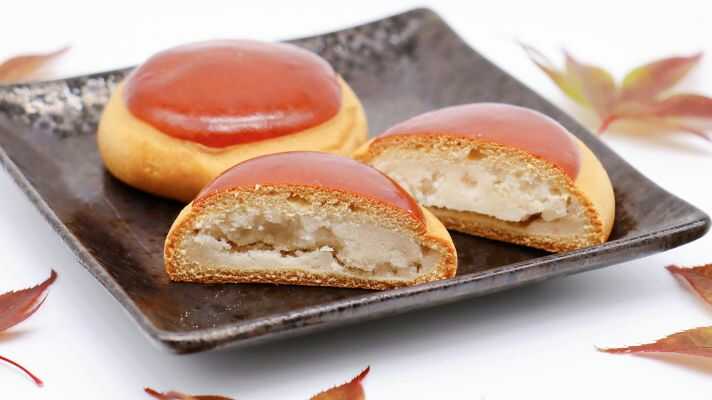
Manju is a traditional Japanese confectionery that consists of a soft, chewy outer dough made from flour or rice flour, and a sweet, smooth azuki bean paste filling. Other fillings such as chestnut, green tea, and sesame are also popular. The dough is kneaded until it reaches the desired texture and then wrapped around the filling, which is then steamed to create a soft and fluffy texture. Manju can come in a variety of shapes, including round, square, and oval. It is often served with green tea and enjoyed as a sweet snack or dessert in Japan. Manju is a popular souvenir from places with famous confectioneries such as Kyoto and Hiroshima.

Click here>>>Japanese Sweets: Manju Steamed Cake with 5 Flavors

Click here>>> Japanese Dorayaki Baked Bean Cake Pack
Nerikiri
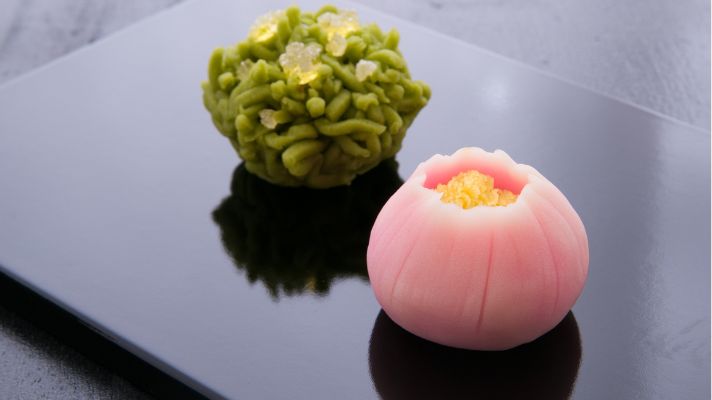
Nerikiri is a traditional Japanese sweet that has a soft and delicate texture, made by mixing smooth white bean paste with sugar, yams, and other natural ingredients such as agar-agar or rice flour. The mixture is then carefully kneaded until it becomes a pliable dough that can be shaped into various forms, such as flowers, leaves, and seasonal motifs. The resulting confectionery is typically very colorful and intricately designed, with each piece carefully crafted by skilled artisans to create a visually stunning presentation. It is often served at tea ceremonies or as a gift during special occasions, and is prized for its subtle sweetness and unique texture.

Click here>>>Nerikiri
Mochi
Mochi-gashi is a traditional Japanese sweet made from mochi, a sticky rice cake, and various sweet fillings. The texture of mochi-gashi is soft and chewy, with a delicate sweetness that is not overpowering. It’s a unique dessert that offers a satisfying and comforting experience for your taste buds.
Mochi-gashi comes in various shapes and sizes, and is often decorated with beautiful designs and colors. Some popular fillings include sweet bean paste (an), strawberries, and matcha green tea. You can enjoy mochi-gashi as a snack or dessert, and it’s often served with a cup of hot green tea or a glass of cold milk.
Mochi-gashi has a long history in Japan and is a popular treat during special occasions such as New Year’s celebrations and weddings. It’s a delicacy that is beloved by many and has become a symbol of Japanese culture.

Click here>>>Kudzu Mochi Jelly
Youkan
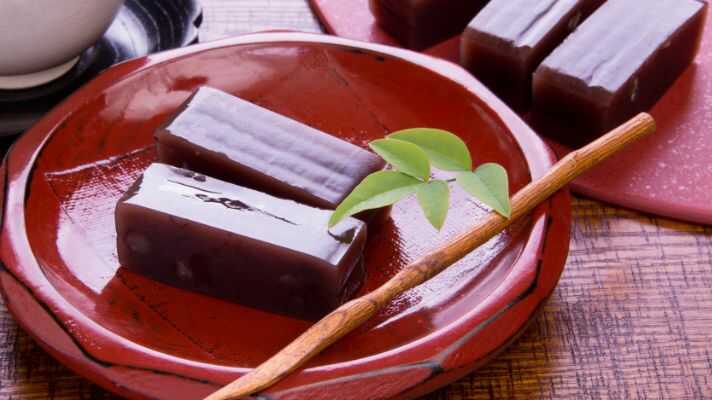
Yokan is a sweet, dense, and gelatinous dessert made from red bean paste, sugar, and agar-agar, a type of seaweed used as a gelling agent. It has a smooth and delicate texture and comes in various flavors, such as green tea, chestnut, and sweet potato.
Yokan has a long history in Japan, dating back to the Edo period (1603-1868), where it was originally served as a luxury treat to the aristocracy. Today, it’s enjoyed by people of all ages and is a popular gift item in Japan.
There are different types of Yokan, including Neri Yokan, which is made from strained red bean paste and has a smooth texture, and Mame Yokan, which is made from whole red beans and has a more textured and chunky consistency. Yokan is often served with a cup of green tea and is a perfect accompaniment to a traditional Japanese tea ceremony.
In addition to being a delicious dessert, Yokan is also considered a healthy snack. Red bean paste is high in protein and fiber, while agar-agar is low in calories and a good source of minerals like calcium and iron.
Overall, Yokan is a tasty and unique treat that’s definitely worth trying if you have the opportunity to sample traditional Japanese sweets.

Click here>>>Toraya Youkan Anko Japanese Toraditional sweets
See also How to Make Japanese Sweet Potato Yokan. There, you will find detailed instructions in English on how to make sweet potato youkan.
Confectionery Containers for Omogashi
When serving traditional Japanese sweets known as omogashi, there are several types of containers used to present and serve them to guests. Two of the most common types of containers are the fuchidaka (縁高) and kashibachi (菓子鉢), while meimeizara(銘々皿)is another type that is sometimes used. The fuchidaka is a heavy, lacquered box-like vessel that is used for serving koicha, a type of thick tea. It typically has five tiers, with each tier containing one type of confectionery. The first customer takes one confectionery from the bottom shelf and passes it to the next customer. Wet kuromoji are placed on the lid, which guests use to cut and eat the sweets. The kashibachi, on the other hand, is a bowl made of porcelain that is also used for omogashi. It is served to guests with wet chopsticks, and guests eat the sweets using their own kuromoji chopsticks. Finally, meimeizara is a small dish that is used to serve omogashi in individual portions. It is often used in tea ceremonies, and is designed to be held in the palm of the hand while eating the sweet with a fork or spoon.
Fuchidaka
Fuchidaka (縁高)is a traditional Japanese container used to serve sweets during tea ceremonies, specifically for koicha or thick tea. The fuchidaka is typically made of wood and is coated with a glossy layer of lacquer, giving it a heavy and durable feel.
The fuchidaka is designed with five tiers, each tier containing one confectionery. When the tea ceremony begins, the first customer takes one sweet from the bottom shelf and sends it to the next customer, and so on. This tradition is believed to symbolize the importance of sharing and appreciating the simple things in life.
To serve the confectioneries, wet kuromoji or “black cherry tree twigs” are placed on the lid of the fuchidaka. The kuromoji is used by the guests to cut and eat the sweets, adding a tactile and interactive element to the tea ceremony experience. The number of kuromoji used corresponds to the number of guests, and they are often selected with careful consideration to complement the overall aesthetic of the ceremony.

Click here>>> Fuchidaka (made by Nakamura Kosai)

Click here>>>Kuromoji
Kashibachi
Kashibachi (菓子鉢) is a traditional Japanese bowl made of porcelain, specifically used for serving omogashi (sweet confections). The bowls are usually round with a flat bottom and are often decorated with elegant designs. Kashibachi is typically presented to guests with a pair of wet chopsticks called “wari-bashi” to prevent the sweets from sticking to the chopsticks. Each guest then uses their own kuromoji chopsticks to pick up and enjoy the sweets. The kuromoji chopsticks are usually made from a thin, flat piece of wood with pointed tips that can easily cut through the confections. Kashibachi is commonly used in tea ceremonies, and the presentation of the sweets in these bowls is considered an important part of Japanese hospitality and cultural etiquette.

Click here>>>Kashibachi
Meimeizara
Meimeizara (銘々皿)is a small and individual plate used to serve food and sweets to each guest, especially in Japanese tea ceremonies. The word “meimei” means “each” or “individual,” while “zara” means “plate” in Japanese. The meimeizara is typically made of porcelain, lacquerware, or wood and can come in various shapes and sizes.
In tea ceremonies, omogashi or traditional Japanese sweets are commonly served on a meimeizara with a small piece of kaishi paper, which is a thin, decorative paper used as a placemat. The kaishi paper is placed on top of the plate and serves as a sanitary layer between the sweet and the plate, while also adding a touch of elegance to the presentation. The guests use their own chopsticks, called kuromoji, to pick up the sweets from the meimeizara.
Outside of tea ceremonies, meimeizara can also be used for serving individual portions of various dishes, such as sashimi or small appetizers. They are often decorated with intricate patterns or designs and can be considered as an art form in themselves.

Click here>>>Meimeizara
Learn How to Eat Higashi in Tea Ceremony through a Video Tutorial
Check out this video to learn how to enjoy higashi during usucha, which is a light tea ceremony according to the urasenke tradition.
- Before you touch the tray, say “osakini”, which means “allow me to go before you”, to the next guest while exchanging “gyo” bow. “Gyo” bows are semi-formal bows.
- Lift the sweets’ tray with both hands about 20 inches above the tatami mat and slightly bow in appreciation.
- Place the tray back on the tatami mat with both hands.
- Take out a full stack of kaishi paper. If you are wearing kimono, take it out from your chest, if you are wearing clothes, take it out from your pouch(袱紗ばさみ・懐紙入れ・数寄屋袋).
In tea ceremony practice and tea ceremonies, a bag is used to carry all the small items necessary, and it is called a “fukusabasami” (袱紗ばさみ) or “kaishiire” (懐紙入れ). If a larger bag is needed, it is called a “sukiyabukuro” (数寄屋袋). The picture below shows a pink fukusabasami and a blue sukiyabukuro.
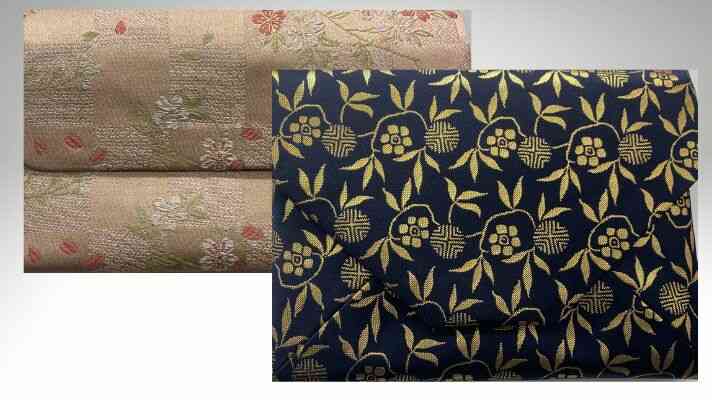

Click here>>>Tea Ceremony Lesson Introductory 6 -piece
- Place the kaishi paper in front of your knees inside the tatami edge with both hands, making sure that the folded side of the kaishi paper points to you.

Click here>>>Konatu Japanese Tea Ceremony Paper Okaishi 30sheets
- Place your left hand on the side of the tray to secure as you pick up the sweet with your right hand.
- Transfer the sweet onto your kaishi paper.
- When your right hand leaves the tray, your left hand also leaves and holds the corner of the kaishi paper to wipe the right fingers which you used to pick up the sweet.
- With both hands, relay the tray to the next guest by placing it closer to the guest outside of the tatami edge.
- Lift kaishi paper on which the sweet is placed with both hands.
- If the sweet is a cracker as in this video, turn over the bottom kaishi paper to cover the top of the sweet.
- Use your fingers to crack the sweet into your mouth size.
- Covering the cracker with the kaishi paper avoids the crumbs to scatter on the tatami mat when cracking it.
- Open the kaishi paper and enjoy the sweet.
Learning Japanese Through the Art of Eating Tea Ceremony Sweets
| 両手 | りょうて | ryoute | both hands |
| 左手 | ひだりて | hidarite | left hand |
| 右手 | みぎて | migite | right hand |
| お盆 | おぼん | obon | tray |
| 持ち上げる | もちあげる | mochiageru | lift |
| 戻す | もどす | modosu | return |
| 取り出す | とりだす | toridasu | take out |
| 膝 | ひざ | hiza | knee |
| お菓子 | おかし | okashi | sweet |
| 拭く | ふく | fuku | wipe |
| 割る | わる | waru | crack |
- Say “osakini”, which means “allow me to go before you”, to the next guest while exchanging “gyo” bow.
- 次客に「お先に失礼します」と言いながら、「行」のお辞儀をする。
- じきゃくに「おさきにしつれいします」といいながら、「ぎょう」のおじぎをする。
- jikyaku ni 「osakini sitsureisimasu」 to iinagara 「gyou」 no ojigi wo suru.
- Lift the tray with both hands.
- 両手でお盆を持ち上げる。
- りょうてでおぼんをもちあげる。
- ryoute de obon wo mochiageru.
- Slightly bow (in appreciation).
- 軽く頭を下げる。
- かるくあたまをさげる。
- karuku atama wo sageru.
- Place the tray back on the tatami mat with both hands.
- お盆を両手で畳の上に戻す。
- おぼんをりょうてでたたみのうえにもどす。
- obonn wo ryoute de tatami no ue ni modosu.
- Take out a full stack of kaishi paper.
- 懐紙を取り出す。
- かいしをとりだす。
- kaishi wo toridasu.
- Place the kaishi paper in front of your knees, (making sure that the わさ[wasa]points to you).
- 懐紙を膝の前に置く。
- かいしをひざのまえにおく。
- kaishi wo hiza no mae ni oku.
わさ(wasa) is the folded side of the kaishi paper.
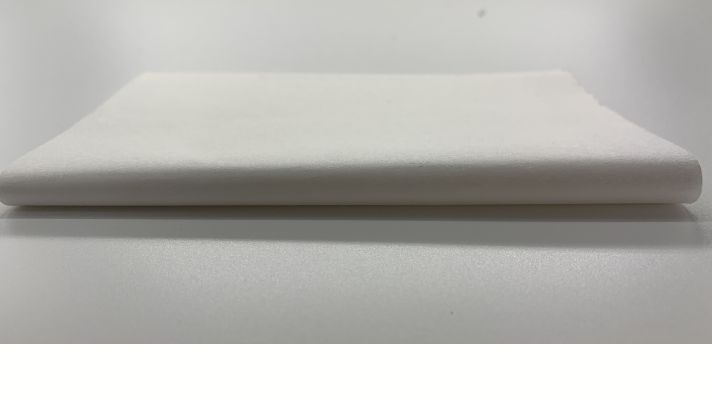
- Place your left hand on the side of the tray to secure as you pick up the sweet with your right hand.
- 左手をお盆の横に添えて、右手でお菓子を取る。
- ひだりてをおぼんのよこにそえて、みぎてでおかしをとる。
- hidarite wo obon no yoko ni soete migite de okasi wo toru.
- Transfer the sweet onto your kaishi paper.
- お菓子を懐紙に移す。
- おかしをかいしにうつす。
- okashi wo kaishi ni utsusu.
- Holds the corner of the kaishi paper to wipe the right fingers which you used to pick up the sweet.
- 懐紙の端で右手の指を拭く。
- かいしのはしでみぎてのゆびをふく。
- kaishi no hashi de migite no yubi wo fuku.
- With both hands, relay the tray to the next guest.
- お盆を次の客に両手で渡す。
- おぼんをつぎのきゃくにりょうてでわたす。
- obon wo tugi no kyaku ni ryoute de watasu.
- Lift kaishi paper on which the sweet is placed with both hands.
- お菓子を置いた懐紙を両手で持ち上げる。
- おかしをおいたかいしをりょうてでもちあげる。
- okashi wo noseta kaishi wo ryote de mochiagemasu.
- Turn over the bottom kaishi paper to cover the top of the sweet.
- 下の懐紙をめくってお菓子の上にかぶせる。
- したのかいしをめくっておかしのうえにかぶせる。
- sita no kaishi wo mekutte okashi no ue ni kabuseru.
- Crack the sweet.
- お菓子を割る。
- おかしをわる。
- okashi wo waru.
- Open the kaishi paper and enjoy the sweet.
- 懐紙を開いて、お菓子を食べる。
- かいしをひらいて、おかしをたべる。
- kaoshi wo hiraite okashi wo taberu.
To learn more, please refer to the following book.

Click here>>>Urasenke tea procedure Guidebook 1 Introductory Level
The following books are recommended for those who wish to learn how to make wagashi.

The kindle version is difficult to read because the font size is not adjustable. I recommend that you purchase the paper book instead of the kindle version.
Click here>>>Tanoshii Wagashi: Little Bites of Japanese Delights
